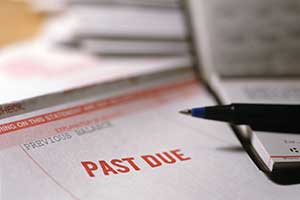
Americans are getting back into the bad habit of thinking they can get whatever they want with borrowed money – the very thinking that caused major problems during the Great Recession.
According to the August quarterly household debt and credit report by the New York Federal Reserve, Americans’ debt rose to a new record high in the second quarter. There was an increase in every form of debt — from mortgage, to auto, student and credit card debt. As of June 30, 2017, total household indebtedness was $12.84 trillion, a $114 billion (0.9%) increase from the first quarter of 2017 and up $552 billion from a year ago. Outstanding consumer revolving debt, mostly from credit cards, hit an all-time peak of $1.021 trillion in June, even higher than the debt level in the 2008 recession peak.
People often get complacent about debt because they are able to make auto and mortgage payments. They then use their credit cards to buy whatever they want, eat out, and take vacations. If something unexpected happens – being laid off from a job, an illness or accident, high medical bills, a crash in the housing and/or stock market — debt suddenly becomes unmanageable unless they have an adequate amount of cash saved to meet expenses.
If you wind up in a situation where you are plagued with household debts you can’t meet, there are answers. he skilled and seasoned Ohio bankruptcy attorneys at Fesenmyer Cousino Weinzimmer understand that even the most well-intentioned people can find themselves in financial trouble. We offer a free consultation to evaluate your financial situation. Call one of our conveniently located office branches at 614-228-4435 (Columbus), 937-222-7472 (Dayton), or 877-654-5297 (Cincinnati) or email for your free consultation.
Problems with Debt
It’s not that all debt is bad – some debt can serve a useful purpose for both individuals and the economy. Debt allows people to buy automobiles, without which they might not be able to go to work; get mortgages, without which they would not be able to afford a home; and pay for education so they can get college degrees that enable them to earn more money. Even some home equity or credit card consolidation loans can be beneficial if they decrease the money you owe by reducing the interest rates.
However, these debts are only good as long as you meet the payments. Economists have observed that both the Great Recession and the Great Depression were preceded by a large run-up in household debt. And if you are taking on debt to fund a lifestyle you can’t afford, or if you overextend yourself or fall behind on your payments, you may well run into problems.
Where is Most Debt?
People commonly run up debts in the following areas:
- Medical – A major medical problem can cause bills to mount up, and since people often take on additional credit-card debt to cover medical bills, debt increases rapidly.
- Mortgages – According to a survey by com, the top source of debt for people in Ohio is mortgage debt, with an average of $125,359 inmortgage debt at the end of the first half of 2016.
- Automobiles – Auto loans have risen to $148 billion. Along with this, auto loan delinquency rates increased slightly, with 3.9% of auto loan balances 90 or more days delinquent on June 30.
- Credit cards – Credit card limits rose by 1.6% in the last quarter.
- Student Loans – Outstanding student loan balances rose to $1.34 trillion as of June 30, with a perilously high 11.2% that was 90+ days delinquent or in default.
The Fed reports that the credit scores of newly originating mortgage and auto loan borrowers shifted downward due to loosening lending standards, a sign that some people may be overextending and taking out loans they can’t afford. Rising credit card debt suggests more Americans are paying high interest rates, an early indicator of future problems.
What to Do About Debt
When taking on any debt, you need to think carefully about risks. Don’t charge anything you can’t pay off by the next due date. If you can’t pay off the balance, you can’t afford whatever product or service you’re paying for with that card.
However, even with careful planning, the unexpected, such as losing a job or being hit with unforeseen medical expenses, can cause debt to become so overwhelming that you can’t meet your payments. If this happens to you, you may wish to consider bankruptcy as an opportunity to get a fresh financial start.
Bankruptcy
Bankruptcy allows you to eliminate or restructure certain debts while under the protection of the federal bankruptcy court. The most common types are Chapter 7 and Chapter 13.
A Chapter 7 bankruptcy allows you to quickly eliminate many types of debt, such as credit card and medical debts. However, it requires that you liquidate your assets, except for those that are exempt, such as cars, work-related tools, and basic household furnishings. (See Ohio home exemption.)
A Chapter 13 bankruptcy allows you to reorganize assets and consolidate your payments to avoid fees and fines and repay some or all of your debt affordably over a three- to five-year period. If you successfully complete the court-approved payment plan, the debts covered by the plan are discharged and you can keep most assets.
Contact Us For Help
If your debts have become overwhelming, we can provide a helping hand. The experienced and compassionate Ohio debt relief attorneys at Fesenmyer Cousino Weinzimmer offer a free consultation to evaluate your entire financial situation. We will examine your income, your debts and your goals and discuss the best fit for you. We will make sure you are aware of all your options and help you decide on the path to a brighter future that makes sense in your individual case. We understand what you are going through and will handle every phase of the process.
Delaying can only make your situation worse, so call the Ohio bankruptcy attorneys at Fesenmyer Cousino Weinzimmer today! Call one of our conveniently located office branches at 614-228-4435 (Columbus), 937-222-7472 (Dayton), or 877-654-5297 (Cincinnati) or email for your free consultation so we can determine what debt relief solutions will work best for you.


